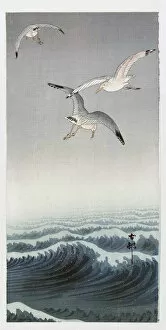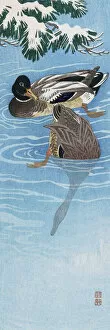Shin Hanga Movement Collection
The Shin Hanga Movement: A Harmonious Fusion of Nature and Art Immerse yourself in the captivating world of the Shin Hanga movement
All Professionally Made to Order for Quick Shipping
The Shin Hanga Movement: A Harmonious Fusion of Nature and Art Immerse yourself in the captivating world of the Shin Hanga movement, where traditional Japanese woodblock prints come alive with vibrant colors and intricate details. This artistic revolution, which emerged in the early 20th century, sought to revive and redefine the age-old ukiyo-e tradition. One such masterpiece that embodies this movement is "Bohemian Waxwing" by Ohara Koson. The delicate brushstrokes capture the gracefulness of this enchanting bird perched on a branch, its plumage radiating shades of crimson and gold against a serene backdrop. Intriguingly diverse subjects were explored within this movement. From adorable depictions like "Five Chicks" or "Chicken and Rooster, " showcasing the innocence of farm life, to more elaborate compositions like "Birds and Plants, " which intertwines nature's beauty with avian elegance. Ohara Koson's talent shines through his work such as "Two Wild Ducks in Water. " Here, he masterfully captures their tranquil existence amidst rippling waves while maintaining an air of mystery surrounding these elusive creatures. Nature lovers will be captivated by "Two Peacocks on a Tree Branch. " With their resplendent feathers cascading down gracefully, they symbolize regality against a backdrop reminiscent of ancient Japanese artistry. Koson's attention to detail is evident once again in his portrayal of an elegant egret standing tall among reeds in his piece aptly titled "Egret. " Every feather seems painstakingly etched onto paper, evoking a sense of serenity that only nature can provide. Delving further into wildlife exploration are pieces like "Two Geese, " capturing their graceful flight across vast skies. Meanwhile, "Kingfisher and Irises" showcases not only the stunning blue hues but also depicts how flora seamlessly merges with fauna within this movement.
























